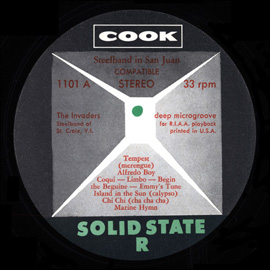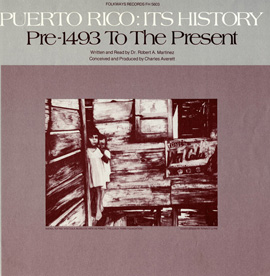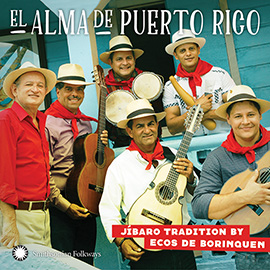Summary
Puerto Rican culture is a representation of the diverse heritages of three cultural groups: Taíno Indians, Africans, and Spaniards. In this lesson, students will learn about the indigenous people of Puerto Rico, the Taíno Indians, and their influence on Puerto Rican culture.
Suggested Grade Level: Grades 2-5
Country: Puerto Rico
Region: Caribbean
Culture Groups: Puerto Rican, Taíno Indians
Genre:
Instruments: Güiro, Güiro Pick (pua), Orff
Language: Spanish
Co-curricular Areas: Spanish, Social Studies, Language Arts, History, Biology
National Standards: 1, 2, 3, 6, 7, 8, 9
Prerequisites: Students have had some experience using various percussion instruments including Orff instruments.
Objectives:
- Students will be able to sing an octave leap alone and together.
- Students will be able to aurally recognize an octave leap.
- Students will be able to correctly identify and play an octave leap on an Orff instrument.
- Students will be able to create sound effects for a given prompt.
- Students will be able to correctly play a repetitive güiro rhythm using their bodies and the instrument.
- Students will be able to sing a song with Spanish lyrics.
- Students will be able to play a Puerto Rican dance song on Orff instruments using correct technique.
Material:
- Puerto Rican güiro and pua (güiro stick)
- Orff Instruments
- Smithsonian Folkways, “Coquí” by Lito Peña from Night at the Tropicoro
- Smithsonian Folkways, “El Coquí” by Suni Paz from Alerta Sings and Songs for the Playground
- Smithsonian Folkways, “Coquí” by The Invaders from Steel Band in San Juan
Lesson Segments:
- The Song of El Coquí- Taíno Myth (National Standards 1, 2, 3, 8, 9)
- “El Coquí” (National Standards 1, 6, 8)
- The Güiro (National Standards 2, 6, 7, 8, 9)
Lesson Segment 1: The Song of El Coquí- Taíno Myth
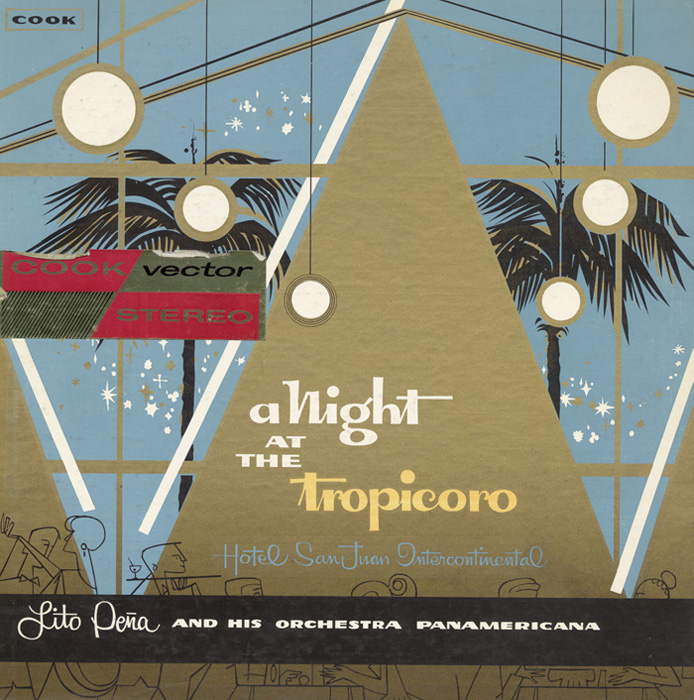
“Coquí”
from A Night at the Tropicoro (1959) | COOK01187
- According to the indigenous people of Puerto Rico, the Taíno Indians, Huracán was the god of strong winds (Galvin, 2009).
- Ask students what familiar word may have originated from this name.
- Read the mythical legend of the God Huracán and the coquí.
- Mohr and Martorell (1995) wrote a version of this tale in the book, The Song of El Coquí and Other Tales of Puerto Rico.
- Throughout the tale, anytime the coquí sings, model its song:

While reading the tale, invite students to join you in the coquí’s song after modeling several times.

- Display pictures of coquíes.

- Review the coquí’s call.
- Explain to students that many coquís live in El Yunque Tropical Forest (Forest of Clouds), and discuss several facts about El Yunque:
- It is located in Puerto Rico (refer to the map below to show where Puerto Rico is located in relation to the US and where El Yunque is located in Puerto Rico).
- It is a popular home to coquís, although they live all over the island.
- It is the only tropical rainforest in the United States.
- It encompasses 28,000 acres of land.
- It receives almost 200 inches of rainfall each year.





- Have students create a “soundscape” of the El Yunque Rainforest.
- Provide students with various pitched and unpitched classroom instruments.
- Display rainforest pictures.
- Direct students to use the instruments around them to recreate the sounds one would hear if standing in the middle of the rainforest.
- Invite students to sing the coquí’s call throughout the soundscape.
- If necessary, reference real sounds of the rainforest: play the beginning or end of (track 106) “Coquí” by Lito Peña from Night at the Tropicoro.
Extension: Each student or small group of students can choose another animal in the story (nightingale, bee, owl, dolphin) and create a call for that animal. Retell the tale and have students be the sound effects throughout the story (thunder, sunlight, etc.). At the end of the story, have each group join in with their call.
Assessment: Listen and assess whether or not students are singing octave leaps correctly by listening to individuals sing the coquí’s call throughout story and soundscape.
Lesson Segment 2: El Coquí
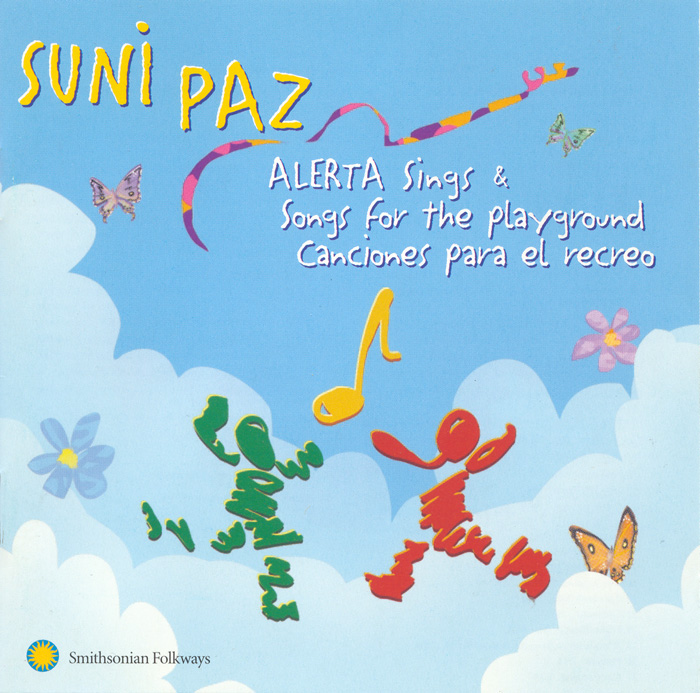
“El Coquí”
from Alerta Sings and Songs for the Playground/ Canciones Para el Recreo (2000) | SFW45055
- Display the coquí picture again and describe the animal: coquís are very small tree frogs that live on the island of Puerto Rico. These small frogs begin to sing at dusk and continue their song until the rise of the sun at dawn. As you heard before, many Taíno Indian myths and artifacts feature the coquí. The coquí is a national symbol and icon of Puerto Rico and many create stories, poems, and songs about the little frog.
- Although the coquí is an amphibian and is considered a frog, it has very different features than a frog you might see around your home.
- Coquíes can be brown, green, or yellow.
- Coquíes can be found in all of the Caribbean Islands, but only the ones in Puerto Rico sing.
- Coquíes do not have webbed toes.
- Coquíes are not born as tadpoles.
- Only male coquíes sing.
- Ask what other species has characteristics that differ between male/female counterparts (example: only male peacocks have brightly colored feathers).
- Review the coquí’s call (A - A’).
- Teach song, “El Coquí” by Suni Paz from Alerta Sings and Songs for the Playground.
- Use lyrics printed on liner notes
Coquí, coquí, coquí/Coquí, qui, coquí!/
En el jardín de mi casa/Entre el espeso follaje/ Una ranita se esconde/Y canta su serenata./
Coquí, coquí, qui, coquí/¡Parece que está de fiesta! Coquí, coquí, qui, coquí/¡Qué lindo canta el coquí!
Translation
Coquí, coquí, coquí/Coquí, qui, coquí!/
In my home’s garden/Inside dense foliage/ A little frog hides/And sings a serenade
Coquí, coquí, qui, coquí/It seems to be in a party mood! Coquí, coquí, qui, coquí/How beautiful the Coquí sings!
- Play recording for students and display lyrics (in Spanish).
- Teach the two “coquí” phrases to the students:
Coquí, coquí, coquí/Coquí, qui, coquí!/
En el jardín de mi casa/Entre el espeso follaje/ Una
ranita se esconde/Y canta su serenata./
Coquí, coquí, qui, coquí/¡Parece que está de fiesta!
Coquí, coquí, qui, coquí/¡Qué lindo canta el coquí!
Ask: Which phrase uses the octave for the coquí call?
- Invite students to sing the coquí phrases as teacher fills in the rest of the lyrics.
- Break the song down by lines.
- Translate what the words mean for students (ask students as you go along if there are any Spanish words they know or recognize).
- Teach correct pronunciations for each line (in rhythm).
- Add melody.
- Sing the entire song together.
Extension: Add additional animal/insect calls created in previous extension. Create new lyrics for each new animal using prompts such as where the creature lives, what they look like, what they like to do, why you like them, etc.
Assessment: Observe whether or not students are singing an octave jump at beginning of song, and correct Spanish lyrics throughout.
Lesson Segment 3: The Güiro

“Coquí”
from Steel Band in San Juan (1964) | COOK01101
- Explain to students that Taíno Arawak Indians used mostly percussion instruments such as maracas and güiros.
- Present a Puerto Rican güiro (present picture if one is unavailable).
- Explain how a güiro is a Taíno rhythm instrument
- Made from a marimbo gourd
- Lines carved into outside of gourd
- Played by moving pua (pick) against the carved lines
- Model a popular güiro rhythm on an instrument. Ask students to use their forearms as the guiro, and two fingers (middle and pointer) as the pua, and play along with you.

- Say: Güiros are still very popular in Puerto Rico today. Listen for the güiro in this piece. Try joining in by “playing” the güiro with your arm.
- Play: “Coquí” by Lito Peña’s Orquestra Panamericana from A Night at the Tropicoro.
- Ask: What other instruments do you hear? (Other instruments in recording are trumpets, saxophones, and additional percussion. It is interesting to point out that Puerto Rican dance bands do not have trombones (from liner notes).)
- Say: Now we are going to listen to “Coquí” again, but this time played by a steel band. Listen for the güiro part and see if you can keep up! (recorded in the streets of San Juan; arranged song above for steel pan by the Invaders from Steel Band in San Juan.
- Introduce the Orff arrangement of this song.
- Stress the importance of the güiro throughout the song.
- Teach everyone the octave coquí call. Point out how each note is played on a C. Review the octave (8 notes apart, same letter name, ect.).
- The notation below is for you. Teach the song by breaking up parts and singing them, not by notation.


Extension: Use the steel pan as a springboard for teaching about more Caribbean instruments or other Caribbean Islands and cultures. You can also relate the güiro from Puerto Rico to a güiro found in Cuba. Compare and contrast the two instruments and teach popular rhythms used for each.
Assessment: Observe students while they “play” the güiro using body percussion to assess whether or not they can match and maintain the beat. Observe students throughout the Orff ensemble piece to assess whether or not they are playing their parts correctly.




